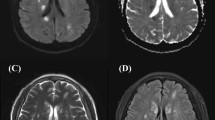Abstract
Idiopathic hypereosinophilic syndrome is an uncommon leukoproliferative systemic disorder characterized by the overproduction of eosinophils and poor prognosis. A major source of morbidity and mortality of this syndrome is the associated cardiac involvement represented by endocardial thickening and mural thrombi. We report a 64-year-old woman with persistent symptoms of heart failure despite standard medical therapy. Echocardiography revealed reduced left ventricular filling due to a large apical mass; an abnormal diastolic filling pattern was also noticed. Complete blood count revealed remarkable hypereosinophilia. Cardiac magnetic resonance imaging demonstrated an apical thrombus and intense linear enhancement of the endocardium, which were compatible with Löffler endocarditis. Medical therapy, including corticosteroids and anticoagulation, was initiated promptly. The symptoms improved as the peripheral hypereosinophilia resolved in 15 days. The patient was asymptomatic at the 1-year follow-up visit with complete regression of the apical thrombus and no evidence of restrictive cardiomyopathy. We report this case to draw attention to this particularly rare condition with poor prognosis since quick and accurate diagnosis and prompt initiation of therapy may improve symptoms and survival.




Similar content being viewed by others
References
Loffler W. Endocarditis parietalis fibroplastica mit Bluteosinophilie. Ein cigenartiges Krankheitsbid. Schweiz Med Wochenscher. 1936;66:817–20.
Hardy WR, Anderson RE. The hypereosinophilic syndromes. Ann Intern Med. 1968;68:1220–9.
Fujimura J, Murakami Y, Tsuda A, Chiba T, Migita M, Fukunaga Y. A neonate with Löffler syndrome. J Perinatol. 2001;21:207–8.
Nakagawa M, Hamaoka K. Myocardial thickening in children with acute myocarditis. Chest. 1993;104:1676–8.
Chusid MJ, Dale DC, West BC, Wolff SM. The hypereosinophilic syndrome: analysis of 14 cases with review of the literature. Medicine (Baltimore). 1975;54:1–27.
Corssmit EP, Trip MD, Durrer JD. Löffler’s endomyocarditis in the idiopathic hypereosinophilic syndrome. Cardiology. 1999;91:272–6.
Solley GO, Maldonado JE, Gleich GJ, et al. Endomyocardiopathy with eosinophilia. Mayo Clin Proc. 1976;51:697–708.
Child JS, Perloff JK. The restrictive cardiomyopathies. Cardiol Clin. 1988;6:289–316.
Spry CJ, Take M, Tai PC. Eosinophilic disorders affecting the myocardium and endocardium: a review. Heart Vessels Suppl. 1985;1:240–2.
Baratta L, Afeltra A, Delfino M, De Castro S, Giorgino F, Rossi-Fanelli F. Favorable response to high-dose interferon-alpha in idiopathic hypereosinophilic syndrome with restrictive cardiomyopathy—case report and literature review. Angiology. 2002;53:465–70.
Tefferi A. Modern diagnosis and treatment of primary eosinophilia. Acta Haematol. 2005;114:52–60.
Pardanani A, Brockman SR, Paternoster SF, et al. FIP1L1-PDGFRA fusion: prevalence and clinicopathologic correlates in 89 consecutive patients with moderate to severe eosinophilia. Blood. 2004;104:3038–45.
Wilkins HJ, Crane MM, Copeland K, Williams WV. Hypereosinophilic syndrome: an update. Am J Hematol. 2005;80:148–57.
Karnak D, Kayacan O, Beder S, Delibalta M. Hypereosinophilic syndrome with pulmonary and cardiac involvement in a patient with asthma. CMAJ. 2003;168:172–5.
Gleich GJ. Mechanisms of eosinophil-associated inflammation. J Allergy Clin Immunol. 2000;105:651–63.
Hagendorff A, Hümmelgen M, Omran H, et al. Löffler fibroblastic endocarditis in the thrombotic stages in isolated right ventricular tissue eosinophilia. Z Kardiol. 1998;87:293–9.
Shabetai R. Restrictive, obliterative, and infiltrative cardiomyopathies. In: Alexander RW, Schlant RC, Fuster V, ed. Hurst’s the Heart. McGraw-Hill. 1998:2085–6.
Fauci AS, Harley JB, Roberts WC, Ferrans VJ, Gralnick HR, Bjornson BH. NIH conference. The idiopathic hypereosinophilic syndrome. Clinical, pathophysiologic, and therapeutic considerations. Ann Intern Med. 1982;97:78–92.
Weller PF, Bubley GJ. The idiopathic hypereosinophilic syndrome. Blood. 1994;83:2759–79.
Bozcali E, Aliyev F, Agac MT, et al. Unusual case of aortic valve involvement in patient with Löffler’s Endomyocarditis: management, follow-up and short review of the literature. J Thromb Thrombolysis. 2007;24:309–13.
Seward J, Tajik AJ. Restrictive cardiomyopathy. Curr Opin Cardiol. 1987;2:488–501.
Gotlib J, Cools J, Malone JM 3rd, Schrier SL, Gilliland DG, Coutré SE. The FIP1L1-PDGFRalpha fusion tyrosine kinase in hypereosinophilic syndrome and chronic eosinophilic leukemia: implications for diagnosis, classification, and management. Blood. 2004;103:2879–91.
Constantine G, Shan K, Flamm SD, Sivananthan MU. Role of MRI in clinical cardiology. Lancet. 2004;363:2162–71.
Shan K, Constantine G, Sivananthan M, Flamm SD. Role of cardiac magnetic resonance imaging in the assessment of myocardial viability. Circulation. 2004;109:1328–34.
Salanitri GC. Endomyocardial fibrosis and intracardiac thrombus occurring in idiopathic hypereosinophilic syndrome. Am J Roentgenol. 2005;184:1432–3.
Ommen SR, Seward JB, Tajik AJ. Clinical and echocardiographic features of hypereosinophilic syndromes. Am J Cardiol. 2000;86:110–3.
Roufosse F, Bartholomé E, Schandené L, Goldman M, Cogan E. The idiopathic hypereosinophilic syndrome: clinical presentation, pathogenesis and therapeutic strategies. Drugs Today (Barc). 1998;34:361–73.
Lefebvre C, Bletry O, Degoulet P, et al. Prognostic factors of hypereosinophilic syndrome. Study of 40 cases. Ann Med Interne (Paris). 1989;140:253–7.
Kushwaha SS, Fallon JT, Fuster V. Restrictive cardiomyopathy. N Engl J Med. 1997;336:267–76.
Wynn SR, Sachs MI, Keating MU, et al. Idiopathic hypereosinophilic syndrome in a 5 1/2-month-old infant. J Pediatr. 1987;111:94–7.
Morton RL, Shoemaker LR, Eid NS. Steroid-refractory neonatal eosinophilic pneumonia responsive to cyclosporin A. Am J Respir Crit Care Med. 1999;160:1019–22.
Schaller JL, Burkland GA. Case report: rapid and complete control of idiopathic hypereosinophilia with imatinib mesylate. MedGenMed. 2001;3:9.
Garrett JK, Jameson SC, Thomson B, et al. Anti-interleukin-5 (mepolizumab) therapy for hypereosinophilic syndromes. J Allergy Clin Immunol. 2004;113:115–9.
Baccarani M, Cilloni D, Rondoni M, et al. The efficacy of imatinib mesylate in patients with FIP1L1-PDGFRalpha-positive hypereosinophilic syndrome. Results of a multicenter prospective study. Haematologica. 2007;92:1173–9.
Moraes F, Lapa C, Hazin S, Tenorio E, Gomes C, Moraes CR. Surgery for endomyocardial fibrosis revisited. Eur J Cardiothorac Surg. 1999;15:309–12.
Lengyel M, Dekov E. Two-dimensional echocardiographic features of Löffler’s endocarditis. Acta Cardiol. 1982;37:59–69.
Schneider U, Jenni R, Turina J, Turina M, Hess OM. Long-term follow-up of patients with endomyocardial fibrosis: effects of surgery. Heart. 1998;79:362–7.
Acknowledgments
No funding or grant was received.
Conflict of Interest
None disclosed.
Author information
Authors and Affiliations
Corresponding author
Rights and permissions
About this article
Cite this article
Cincin, A.A., Ozben, B., Tanrikulu, M.A. et al. Large Apical Thrombus in a Patient with Persistent Heart Failure and Hypereosinophilia: Löffler Endocarditis. J GEN INTERN MED 23, 1713–1718 (2008). https://doi.org/10.1007/s11606-008-0705-y
Received:
Revised:
Accepted:
Published:
Issue Date:
DOI: https://doi.org/10.1007/s11606-008-0705-y




